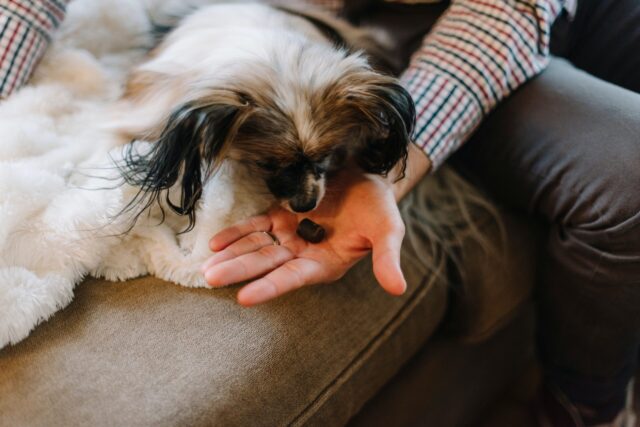Does your dog love you so much that the separation anxiety hits the instant you’re not in sight? Do they destroy furniture or tear up things other than their toys? Perhaps your anxious dog can’t stop howling or whining. Or maybe they pace back and forth in constant search of you.
If any of this sounds familiar, your pup isn’t alone in their worry or the accompanying behaviors. According to Today’s Veterinary Practice, Separation anxiety is the number one type of anxiety in dogs, and at least fifty percent of dogs will experience this worry at some point in their life. Like other forms of anxiety, it can range from mild to severe.
What is Separation Anxiety?
Dogs are social creatures and thrive on attention from loved ones. But sometimes, our furry besties can develop an overly-attached bond that results in them feeling stress and worry when we have to leave them. These heavily bonded pups tend to express their upset at being separated from their favorite human or humans with destructive and frustrating behaviors you’d never expect of them.
And your dog’s separation anxiety may not extend to every one of your departures from the house. Perhaps they don’t cry and pace when you go to work because it’s a pattern they know. It could be their anxiety only acts up if you head out on evenings or weekends when they aren’t used to you leaving.

But whether your dog’s anxiety is mild or severe, occasional or daily, you’ll notice certain behaviors cropping up again and again. Here are six of the most common symptoms of separation anxiety in dogs:
- Soiling the house
- Excessive vocalization, like howling, whining, and barking
- Destruction by chewing and digging
- Escaping the house, enclosed pens, or crates
- Back-and-forth pacing
- Eating their stool
If your dog is experiencing any of these symptoms or exhibiting any other troubling behaviors, contact your veterinarian. Your dog’s care team can rule out other issues and provide tips on how to help your furry one find some peace.
How to Help Your Dog with Separation Anxiety
There are several ways to help minimize separation anxiety. While you may never be able to rid your dog of it entirely, these tips can help reduce their worry and make them more comfortable. And remember, scolding and punishing your pup is never the answer to solving anxiety. Negative reinforcement will only make the problem worse. It’s all about the positive vibes here!
Leave Your Scent Behind
Give your dog something you’ve recently worn that smells like you before you leave the house. Having your scent close can help ease their stress. Place the article of clothing or even a blanket you commonly use in your dog’s bed, crate, or anywhere they like to spend their comfy time.
Pressure suits and calming vests can also provide dogs with anxiety relief. If your dog is one that finds the close fit a soothing experience, give them a double dose of comfort by wrapping it in your worn clothing for a while so it picks up your scent.
Related: 10 Best Snout Soothers for Dogs
Plenty of Physical Exercise
One of the best aides for anxiety is exercise. Providing your dog with at least thirty minutes of physical activity daily can help burn away nervous feelings. And it’s up to you and your pup how the two of you get that exercise. Go for walks, hikes, or jogs. Play fetch or tug of war. Maybe a good swim when the weather permits. Whatever activity your dog enjoys, make sure they’re getting plenty of time to do it for their mental health.

Mental Stimulation
Don’t forget that doggy brain. It needs exercise too! Food puzzles, lick mats, and other toys designed to distract dogs are a great way to train that brain and quiet anxiety symptoms. Check out Petkeen for a list of toy solutions for separation anxiety.
Calming Supplements
Many dog parents have turned to calming supplements made with natural components to offer their pups relief from their stress. Some of the most common ingredients found in calming chews include L-theanine, L-tryptophan, chamomile, and melatonin. Vitamin B1, or thiamine, is an essential vitamin needed for healthy central nervous system function that’s also been shown to provide stress relief. And to make dosing easy, most dog supplement brands offer calming soft chews that look and taste much like a treat.
RELATED: The 10 Best Calming Supplements For Dogs

Hemp has become a hot topic in recent years thanks to the relief it offers many canines combating various illnesses and conditions. And while there isn’t much in the way of scientific research to back up hemp as an effective treatment for many issues, including separation anxiety, dog parents who use it with their dogs tend to swear by the results.
To learn more about Hemp and separation anxiety in dogs, Petkeen breaks down the facts.
Keeping a Regular Schedule
Like us, dogs are creatures of habit. The more they keep to a routine, the better they feel in life. And this goes doubly for dogs with any kind of anxiety. If your pup knows you’ll be back when the work day, classes, or any other regularly scheduled events are done, the established pattern can help bring them a sense of ease about being alone for a little while.
Develop a Departure Routine
When you’re dealing with separation anxiety in your dog, leaving the house isn’t such a simple thing. But there are some steps you can take to make leaving a little easier on your pup. VCA Hospitals recommends that leaving should be minimized. While you’re getting ready, keep your dog in a separate room so they don’t see you doing the tasks that mean you will be leaving. And when the time comes to head out the door, don’t make a fuss about saying goodbye and lavishing love. Slip out the door quietly and without fanfare.
But these aren’t the only solutions for helping your dog with separation anxiety. Check out PetKeen’s veterinarian-reviewed information to discover more ways you can help your dog. And if you’re family also includes kitties, check out Excitedcats.com to learn more about the feline kind!



 Toledo, United States.
Toledo, United States.